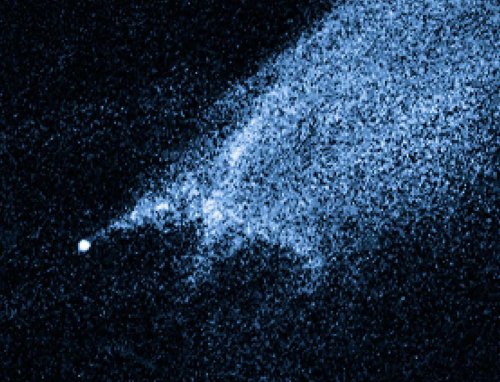The image shows a strange X-shaped object at the head of a tail of material similar to that of a comet. The finding is published in the October 14 issue of Nature

Astronomers using the Hubble Space Telescope have captured a rare image of what happened shortly after an asteroid collided. The image shows a strange X-shaped object at the head of a tail of material similar to that of a comet. The finding is published today in the October 14 issue of Nature.
Starting in January 2010, astronomers followed the object known as P/2010 A2 for five months. At first they thought they were witnessing a fresh collision of asteroids, but they were amazed to find out that the collision had taken place a year earlier - at the beginning of 2009.
"We expected the debris field to expand dramatically, like shrapnel ejected from a hand grenade," says astronomer David Jewitt of the University of California, Los Angeles, who is the lead researcher on these Hubble observations. "But what we discovered was exactly the opposite, we found that bone spreads very, very slowly."
P/2010 A2 is in the asteroid belt, a reservoir of millions of rocky bodies between the orbits of Mars and Jupiter. Astronomers estimate that medium-sized asteroids collide with each other at an average of one such collision per year. Capturing the asteroid in the act of colliding is difficult because very large collisions are rare while small ones, such as the one that produced P/2010 A2, are very faint. The Lincoln Near-Earth Research (LINEAR) skyscanner program discovered the strange object with the comet's tail in January 2010, and some astronomers thought it was indeed a comet, but only Hubble's ability to separate the X-shaped pattern offers unique evidence that something stranger than a comet is responsible to configuration.
Hubble's images taken between January and May 2010 using the Wide Field Camera No. 3 revealed a point-like object about 130 meters in diameter, with a tail of dust trailing behind a never-before-seen formation behind the letter X. Its core contains enough dust to form a ball with a diameter of About 20 meters, most of it comes out of the larger body by the body that caused the explosion. The 130-meter-diameter bone in Hubble's photo is a remnant of a body that was previously only slightly larger.
The astronomers believe that a small rock, perhaps 3-5 meters in diameter, collided with a larger body, at a high speed of about 17 thousand km/h, which caused it to crash and disintegrate and tear a strip of material from the larger body. Jewitt estimates that the violent encounter took place in February or March 2009 and was strong enough - like the explosion of a small atomic bomb.
Astronomers do not have a good explanation for the X configuration seen at the top of the tail, and they believe that the large asteroid that hit was not symmetrical. Materials ejected in the impact did not cause a symmetrical pattern, but a sort of splash of a rock thrown into the lake. The large particles in the X pattern dispersed very slowly and gave the structure its longevity.
The astronomers plan to use Hubble again this year and observe the bone. Jewitt and his colleagues hope to see how far the dust was able to disperse in space thanks to solar radiation, and also try to estimate how the mysterious X shape was created.

6 תגובות
Asteroid tc3 entered the atmosphere and burned up.
The location is a desert in North Sudan.
200 meteorites were collected which are the remains of the asteroid.
A documentary was broadcast about a week ago on television.
The film describes all the steps, including an expedition that collected the meteorites (remains of the asteroid) in the desert (for about a week).
Fascinating ~~! Thanks for the article!
An asteroid made like stone?
From later photographs (in the original article) you can see that the X configuration has disappeared.
.
.
.
.
.
Apparently Google hides it.
NASA managed to stop Nibiru X!
Well, now the conspiracy theorists will come and say that NASA managed to stop Nibiru X...